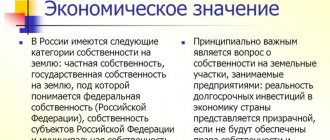The right of common ownership of land plots refers to the types of private ownership of land and is characterized by a plurality of subjects of property rights, called participants in common property or co-owners, when using a land plot together (Article 244 of the Civil Code of the Russian Federation). In essence, the emergence of common property is the unification of subjects of land ownership and the connection of land plots into a single object, confirmed by an act of state registration. The right of common ownership of a land plot is divided into two types:
- General joint ownership of land (without determining shares).
- Common shared ownership of land (with determination of the shares of each co-owner).
The differences between the types of common property rights concern both the scope of the powers of the owners and the institution of the emergence of legal relations. Let us consider each type of common land ownership separately.
Common property and its varieties
Land relations are regulated by the Land Code of the Russian Federation, however, the right of ownership of land is also covered by the norms of civil legislation, and is regulated in certain situations by other special regulations.
Art. 244 of the Civil Code of the Russian Federation establishes the types into which the right of common ownership is divided. Thus, each property, not excluding land, can be owned by several entities, and all of them can own a specific share in it. The legislator calls this type of property shared.
There are situations in which shares in property are not established, then the land or other object will be jointly owned. This means that the rights to the land plot of any co-owner will extend not to part, but to the entire plot as a whole, but subject to the restrictions set by the Civil Code.
About the division of property
The concept of common shared or joint property also implies the rules for its division. Thus, a co-owned territory can be divided into separate real estate objects and transferred to other categories according to their intended purpose, if the area of the new territories meets the minimum requirements of the Land Code. After the division, each resulting object is registered as the property of a single owner.
State registration, following which newly formed territories are assigned a new personal cadastral number, is a mandatory procedure. In this case, the relationship and the shared ownership itself will be terminated altogether. But this requires everyone's consent.
co-owner, which is often a stumbling block and the cause of conflicts.
If the division of the plot causes damage to it or the division is not at all possible, the participant who wishes to terminate the relationship with the shareholders has the right to refuse his part of the property and demand in return a financial payment equal to the value of his share.
Joint ownership
As a general rule, almost any common property is considered shared property, unless regulations establish that it is joint. Based on legislative norms, joint property is recognized as:
- The property of spouses acquired by them in the union. Taking into account the requirements of Art. 256 of the Civil Code of the Russian Federation, such property will be considered joint, unless it is acquired by the husband or wife before or after marriage, is not received as a gift and does not constitute an item for personal use. At the same time, shares in such property can be established on the basis of an agreement between husband and wife or by decision of a judicial authority.
- Farm property. Based on the interpretation of Art. 6 of the Law “On Peasant (Farm) Economy”, the assets of this association of citizens belong to them by right of joint ownership. However, like spouses, participants in a peasant farm have the right to establish the shares of each of them by concluding an appropriate agreement.
- The property of a gardening or other non-profit citizens' union, which is acquired by this society through contributions from its members, is also joint (Article 4 of the Federal Law of April 15, 1998 No. 66-FZ).
- Privatized property.
The difference from shared property is that the disposal of joint property can be carried out exclusively with the consent of absolutely all co-owners. For example, to sell land owned by a married couple, it is necessary to obtain the consent of the second spouse. In the absence of such, the latter has the right to demand recognition of the transaction as invalid through the court if he proves that the buyer knew, or at least should have known, about the need to obtain this permission.
Joint property can be divided, but to do this, first of all, it must be transferred to shared ownership. Also, creditors have the right to foreclose on a plot that is jointly owned. To do this, it is necessary to apply to the court with a claim for the allocation of a share, and subsequently apply a penalty to the allocated share (Article 255 of the Civil Code of the Russian Federation).
How to split a hundred
The division of common property between spouses often becomes a complex legal problem. Especially if we are talking about the division of not purchased, but once received free land.
After all, in the Soviet years, local authorities allocated plots for gardens and vegetable gardens not for any specific family, but for a citizen, employee of an enterprise or organization. Now the vast majority of summer residents have registered these acres as their property. How to divide them during a divorce? What about common property? But how common is it? According to the documents, one person received it.
The story that the Supreme Court dealt with began in a trivial way: a citizen filed a lawsuit with the district court. It contained a request - first to dissolve the marriage, and then to divide the jointly acquired property in half between the spouses.
The property consisted of two plots of land, a snowmobile, a car and two houses, one of which was residential and the other unfinished.
The court of first instance partially satisfied the citizen's claim - it dissolved the marriage and divided the residential building in half. The rest of the claim was denied. The appeal agreed with this decision.
The district court explained the refusal to divide the plots as follows: according to the Family Code, the land in question in the dispute does not belong to the common property of the spouses, since the ex-husband received hundreds of acres under the so-called “gratuitous transaction.”
After such a decision, the dissatisfied former half had to go to the Supreme Court of the Russian Federation, defending their rights. The Judicial Collegium for Civil Cases of the Supreme Court of the Russian Federation studied the arguments of the dissatisfied plaintiff and said that the applicant was right, and their colleagues made a decision “with significant violations of substantive law.”
In the event of a divorce, the court will divide the free hundred square meters received from the local authorities in half between the spouses
And this is how the high court explained its position. He started with the Family Code of the Russian Federation. There are several articles devoted to the common property of spouses. Thus, Article 34 of the Family Code lists what belongs to this common property of the spouses and what does not apply to it. All income and everything purchased during the marriage, no matter who it was registered to or who contributed the money, is shared.
In addition to things and money, movable and immovable property, shares, securities, shares in capital contributed to credit institutions or other commercial organizations are considered common.
Property owned by each spouse before marriage will not be considered community property. And the goods received during the marriage as a gift, by inheritance or through so-called “gratuitous transactions” will be personal. This is stated in Article 36 of the Family Code of the Russian Federation.
From the materials of this legal dispute, the Supreme Court saw that the spouses’ two plots were formed from one plot, which the former spouse received back in 1984 from local governments for gardening for “perpetual use.”
By the way, at the time of receiving the hundred square meters for the dacha, the citizen had been in a registered marriage for almost six months.
Later, the man registered ownership of these acres. Over twenty years of marriage, the once single plot of land was divided into two plots for family reasons.
Next, the Supreme Court of the Russian Federation moved on to the Civil Code.
There, Article 8 states that civil rights and obligations arise, among other things, from contracts and “other transactions, although not provided for by law, but not contrary to it.” And also from acts of state bodies and local governments.
Thus, the Supreme Court of the Russian Federation concludes, the legislator distinguishes between agreements (transactions), acts of state bodies and local government bodies as grounds for the emergence of civil rights and obligations and does not classify the latter as gratuitous transactions.
The Supreme Court of the Russian Federation emphasized an important circumstance - the free transfer of land to one of the spouses during marriage on the basis of an act of a local government body cannot be the basis for classifying it as the personal property of this spouse.
The conclusion of the Judicial Collegium for Civil Cases of the Supreme Court is as follows.
Since the former spouse’s ownership of the disputed plots of land did not arise on the basis of a gratuitous transaction, the conclusions of local courts regarding the classification of this disputed property as the personal property of the defendant in accordance with Article 36 of the Family Code of the Russian Federation contradicts the provisions of the law. According to the Supreme Court of the Russian Federation, under such circumstances the local courts had no grounds for refusing the plaintiff’s request. Namely, to divide these land plots equally between the former spouses.
Definition No. 64-KG17-10.
Shared ownership of land
Among the reasons on which the type of property under consideration may arise are the following:
- Emergence from legislative acts.
- Formation as a result of the acquisition of an indivisible object into the ownership of two or more entities.
- Arising from contractual relations.
The share of each co-owner in the type of common property under consideration is usually specified by agreement. Such shares are determined by the contributions of the participants, how much each of them contributed to their common property. So, when buying a plot of land by two persons, if their financial costs are the same, then the share of both will be the same - ½ for each. If their contributions are different, then the shares are determined in proportion to these contributions.
In the absence of an agreement on the establishment of shares, and also if the size of these shares cannot be determined in accordance with the law, they are considered equal.
Possession, use and disposal of the site
The disposal of a land plot that is in shared ownership and the disposal of a certain share in this plot are different. To complete a transaction in relation to the entire such plot, an appropriate agreement of all co-owners is required. When buying or selling a plot of land that is in shared ownership, all co-owners will act as sellers. In case of disposal of shares of a land plot, the consent of the co-owners is not required. The owner of a certain share can dispose of it at his own discretion, however, in a paid transaction, he will have to comply with the right of first refusal.
Possession and use, as established by Article 247 of the Civil Code of the Russian Federation, is carried out by co-owners in the same way as an order, that is, on the basis of an agreement between them. Participants in shared ownership can use the property both as a whole and in parts. The choice in favor of one type or another is determined depending on the object. In relation to a land plot, the owner of the share can use either his part of the land directly, or, with the consent of the others, the entire plot.
Ownership and use of agricultural land plots that are in shared ownership are regulated by Federal Law No. 101-FZ dated July 24, 2002 and have their own characteristics. In order to exercise these powers, it is not necessary to obtain the consent of all participants. As a rule, such a decision is made at a meeting at which at least 20% of the co-owners must be present. If 2/3 of the votes are received, the decision on the procedure for owning and using the land plot is considered adopted. This procedure is due to the fact that often agricultural lands have a huge number of owners, and obtaining appropriate consent from each of them in most cases becomes impossible.
What it is
With common ownership, ownership, use and disposal of land real estate is carried out simultaneously by several right holders - citizens or legal entities. The key difference between joint and shared forms of ownership of an allotment is the presence or absence of a certain share in each right holder. In this case, the site under common law is characterized by the following nuances:
- the subject of law is a single land plot with certain boundaries, and in the shared form, the boundaries of individual shares can be established;
- in case of joint ownership of land, any forms of disposal (sale, donation, lease, etc.) can only be carried out with a unanimous decision of all right holders, and each owner must be a party to the transaction;
- when securing shared ownership, it is possible to dispose of individual shares, however, in case of alienation for compensation, it is necessary to comply with the procedure for notifying all shareholders and granting them the right of first refusal.
The emergence of a common right to a plot occurs in cases where several persons act as acquirers. To do this, a general application is submitted to the authorities, or the purchase and sale agreement includes several buyers. It is important to take into account that the regime of joint ownership can be changed to a shared form at any time; to do this, it is enough to enter into a voluntary agreement on the distribution of shares, or to achieve the forced allocation of shares through a judicial procedure.
Let us consider the reasons for the emergence of joint and shared forms of land ownership, as well as the features of the disposal of common plots.
Income from property and expenses for its maintenance
A plot of land, used in accordance with its intended purpose, naturally brings income and other fruits. Their distribution can be carried out between co-owners in two ways, in which the income and products received:
- become part of the common property;
- distributed proportionally among the co-owners according to their shares.
The owners can establish a different procedure by concluding an appropriate agreement.
The maintenance of common property is an integral part of its use and ownership. Therefore, all owners must bear the costs of maintaining the land plot. Moreover, these costs are also set in proportion to shares. A participant in shared ownership of land who has paid, for example, land tax for the entire plot, has the right to demand compensation from the others in proportion to their shares. On the other hand, some expenses can only be carried out with the consent of all owners. Thus, a participant in shared ownership who has paid for the protection of the entire land plot without the consent of the other owners will not have the right to demand compensation from them.
Pre-emptive right to purchase
As stated above, the owner of the share has full right to dispose of his part of the land plot. Without obtaining the approval of other participants, he can donate his part of the land, pledge it, etc. However, if he wants to make a paid transaction, then for this he needs to follow a certain procedure. Each co-owner has a pre-emptive right to purchase the share of the other participant.
The owner of a part of the land plot, before selling it, must invite the other participants to buy out his share. The price is set by the owner himself. If the remaining owners of shared ownership refuse to purchase this share, he does not have the right to sell it at a price lower than the one for which he offered it to them.
Article 250 of the Civil Code of the Russian Federation stipulates that a person intending to sell a share must notify all co-owners in writing. This notice must state the price and other terms of sale. If within one month none of the participants declares a desire to buy out the share on such terms, then the owner of the share can freely sell it to a third party.
If these rules are violated, the co-owners have the right to demand through the court that such a transaction be declared invalid. To do this, they are given a three-month period (from the moment they learned about their violated right).









